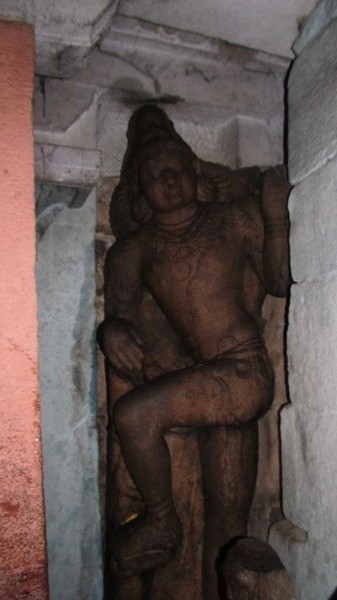Kailasamundaiyar Temple, Cholamadevi, Trichy
Kailasamundaiyar
Temple is a Hindu Temple dedicated to Lord Shiva located at Cholamadevi Village
in Trichy District of Tamilnadu. The Temple is located amidst the lush green paddy
fields and sylvan surrounding on the northern banks of the Uyyakondan channel.
History
The
highlight of the temple is that it was built by Rajaraja Chola I, who also
built the internationally famous Big Temple of Tanjore. It dates to the 11th
century (1065 A.D) and is a treasure house of historic information.
The
Temple
The Siva
Temple consists of a central shrine, ardha and Mahamandapams. The presiding
deity, the Linga has a square base. The four-pillared Ardha Mandapam has
exquisite in the front. Two Dwarapalas sculpture adorn the entrance of the Ardhamandapam. The
main deity (Shiva) is called as Kailasamundaiyar. The Goddess is named as
Karpagambal. The temple is in dilapidated state today. As the shrine of Goddess
is not in good condition, the idol of Goddess is also placed near Shiva Linga.
The main
shrine has the big relief images of Dwarapalas. They look somewhat similar to
the images of Tanjore Big Temple. The small bali peetha and Nandi idol are
found facing the temple under the open space. A lot of idols that are excavated
in and around the site are placed inside the temple - Ayyanar with two
consorts, Kaumari, Murugan and Valli, Chandikeswarar, Surya, Vishnu Durgai and
another Goddess.
Ganesha,
Dhakshinamoorthi, Bhikshatana, Vishnu, Brahma and Durga are found as koshta
idol surrounding the temple wall. The image of Dhakshinamoorthi is completely
destroyed. The other idols look very attractive. In the temple wall, there is a
small hole with the relief image of snake; it is the hole which was left for
the snakes to enter inside the temple, it is believed.
Inscriptions
The
temple, dating back to the 11th century, is a virtual treasure house of
historic information pertaining to the Cholas. The adhishtana and the walls of
the temple are fully covered with inscriptions belonging to the periods of Raja
Raja Chola I, Rajendra Chola I and Vira Rajendra Chola I. A majority of the
inscriptions belong to Raja Raja I. As per the inscriptions, the village was
once called as 'Thenkarai Brahmadeyam Sri Cholamadevi Chadurvedi Mangalam'.
This village was an important site during those times. It is said that
Cholamadevi (referred in this place) was the 13th wife of
Rajaraja Chola; he built this temple and a palace nearby for his queen. As per
one of the inscriptions found in this temple, a huge flower garden measuring
around 7 acres was there adjoining the temple; the flowers were used to be sent
til the far-off Kanchipuram city.
Inscriptions about Saareerakabhashya:
Further,
the inscriptions contain the earliest known reference to Saareerakabhashya, a
commentary on Sankara's philosophy, written by Chidaananda Bhattaara. The
inscription is in Tamil with a few Sanskrit words in between written in Grantha
characters. This inscription in Cholamadevi belongs to the reign of Vira
Rajendra Chola (1063-1069 C.E.). It records the grant of land, upon a royal
command, for the maintenance of a teacher, who taught a Varttika called
Pradeepaka, written by Chidananda Pidariar. The epigraph says this Varttika was
a commentary on a work known as Saareerakabhashya, written by one who bore the
title of Bhagavatpada.
The
inscription could be assigned to 1063 -1069 C.E., the Varttika must have been
written at least 50 or 60 years earlier, for it to have been learnt and
expounded, and for a king to have provided a grant for teaching it. That would
mean that the Varttika was perhaps written during the reign of Raja Raja I. As
for the name Saareerakabhashya, used in the inscription, Sankara’s Brahmasutra Bashya.
Ramanujacharya’s Bashya, popularly known as Sri Bashya is also referred to as
Saareeraka Mimamsa Bhashya.
But the
possible date of composition of the Varttika mentioned in the Cholamadevi
inscription, means it cannot be a commentary on Ramanuja’s work, because the
latter was born in 1017 C.E. Moreover, the honorific of Bhagavatpada is used
for Sankara, and not for any other preceptor. The inscription is engraved very
close to the place intended for Dakshinamurthy, although the icon is now
missing. In the Advaitic tradition, Dakshinamurthy Ashtaka is recited before
and after the conclusion of Sankara Bashya classes.
So, the
location of the inscription was further proof that the Saareerakabhashya
referred to in the Cholamadevi inscription was Sankara’s Bashya. Classes for
teaching Chidananda Pidarar’s Varttika were also probably held somewhere close
to the Dakshinamurthy sannidhi. In conclusion, the inscription reveals the
following interesting facts: Sankara’s Brahmasutra Bashya was popularly known
as Saareerakabhashya in Tamil Nadu; Sankara was referred to by his honorific Bhagavatpada,
in Tamil Nadu, as early as the 11th century; a Varttika existed for his Bashya
in the 11th century; the Varttika was considered significant enough for a Chola
king to make arrangements for it to be taught.
There is
no information about Chidananda Pidarar. Pidarar is an honorific in Tamil,
equivalent to the Sanskrit Bhattaraka or Bhattaara. Unfortunately, Chidananda
Pidarar’s Varttika is lost to us. Interestingly, the inscription says that the
village assembly which declared the royal grant for teaching of the Varttika,
met in the courtyard of the Vishnu temple in the village. The inscription
refers to the Vishnu temple as Thirumaliruncholai Alwar temple. There are other
inscriptions in the Siva temple that talk of provisions for conducting various
services in the temple. In all these cases, the village council is said to have
assembled in the courtyard of the Vishnu temple, to sanction these grants. But
no traces of Vishnu Temple are found here.
Connectivity
The
Temple is located at about 700 meters from Cholamadevi Bus Stop, 4 Kms from Thiruverumbur,
21 Kms from Chatram Bus Stand, 20 Kms from Trichy Central Bus Stand and 16 Kms
from Trichy. Nearest Railway Stations are located at Thiruverumbur (5 Kms) and
Trichy (19 Kms). Nearest Airport is located at Trichy (14 Kms).
Location
References


















